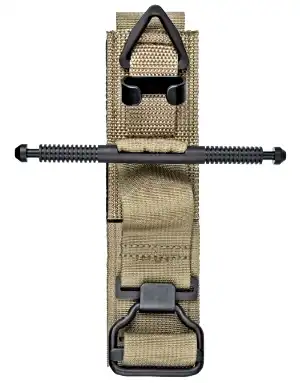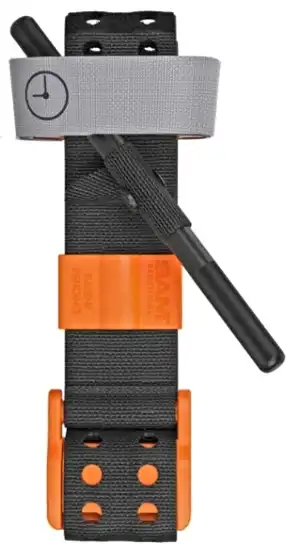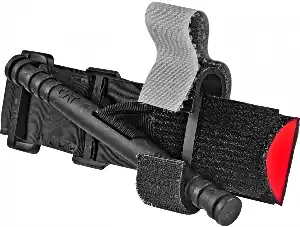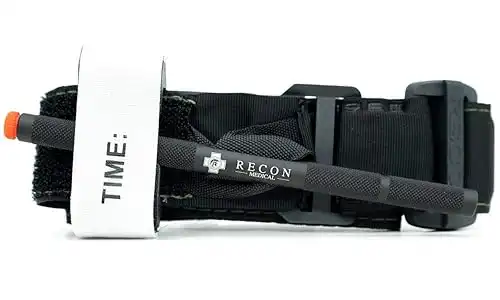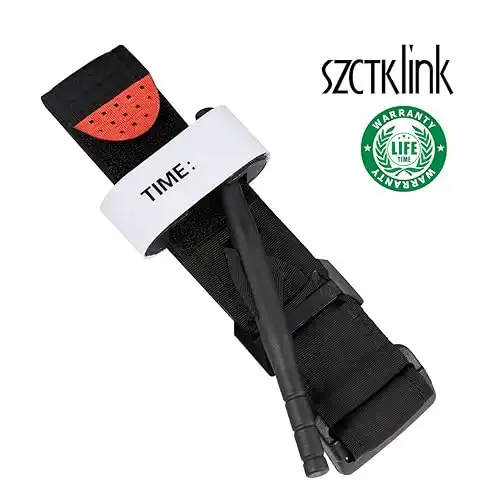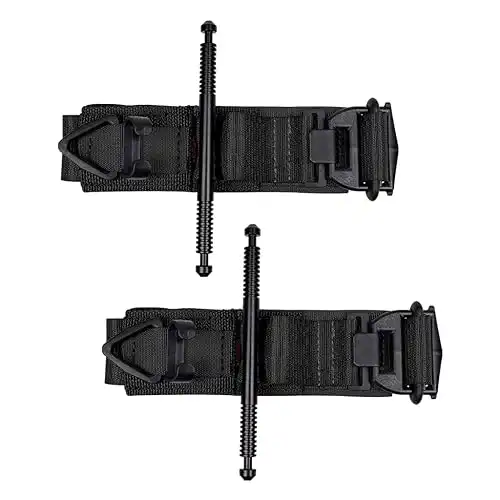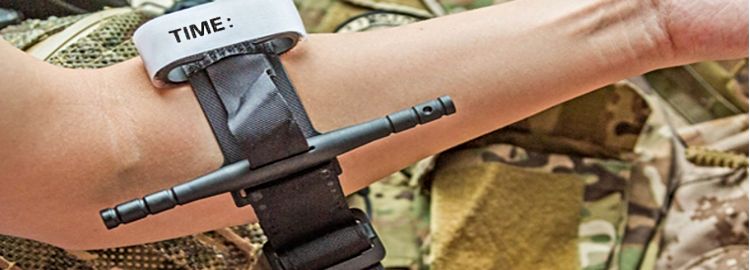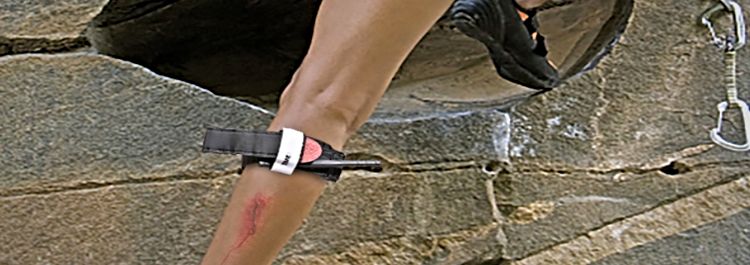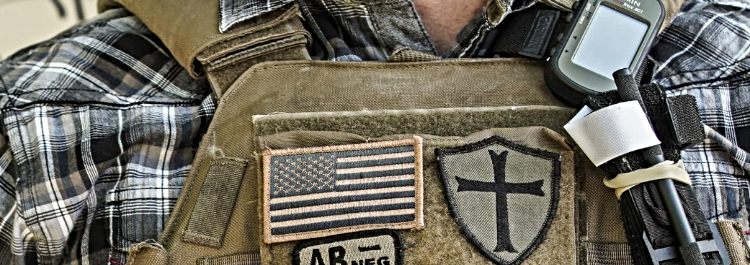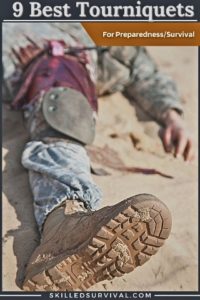
A Complete Guide On Buying (and Using) A Tourniquet In A Pinch
Because with severe injuries you must stop the blood loss FAST!
Otherwise, it’s lights out in mere minutes.
That’s why it’s one of the important tools in a IFAK Medical Kit, TFAK, or Bug-Out Bag.
So invest in a good one and learn how to use it…
TOPICS IN THIS GUIDE… ↓(click to jump)
- 7 Best Tourniquets On The Market
- What Is A Tourniquet Anyway?
- Why Everyone Should Own One
- 7 Types Of Tourniquets (Pros/Cons)
- What To Look for In A Tourniquet
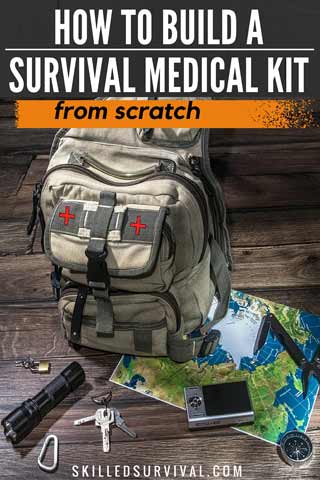
Want a free survival medical kit checklist?
Click here to instantly download this Complete Checklist PDF. No purchase necessary.Best Tourniquets On The Market Today
Here are the best tourniquets you should add to your EDC medical kit:
The SOG is made in the USA and is US Army Institute of Surgical Research tested.
They proved it to be 100% effective at stopping arterial bleeds.
And this application is the same for either arm or leg.
It's easy to use and made of durable, lightweight materials.
It has a machined aircraft aluminum handle and high-impact plastic Acetyl tri-rings.
There are also safety screws to prevent accidental pressure release during patient movement.
This fastening system works great in bad weather conditions like rain, snow, and mud.
This SOG is the top performer you want in your go bag.
↓ SOF Tactical Tourniquet
The SAM XT is ideal for rapid application to stop uncontrolled bleeding.
It requires fewer windlass turns to tighten, making it easier and faster.
TRUEFORCE auto-locking buckles eliminate unnecessary slack.
And a TRUFLEX plate that distributes force to increase targeted pressure while maintaining flexibility.
There is also a metal windlass rod.
It's both lightweight and durable.
It also has an all-weather precision strap made of single-layer nylon webbing.
The bottom line is:
This is another excellent option that easily slips into any gear bag.
↓ SAM XT Training | High & Tight Application
This CAT is the one officially used by the US Military.
It has a great hook and loop windlass system.
It provides the ideal circumferential pressure to the limb along with a dual securing mechanism.
The windlass rod is reinforced with a larger diameter for better strength.
And is ribbed for a superior grip.
It can also work in any weather and is 100% effective in both upper and lower extremities at impeding blood flow.
A stabilization plate with a beveled contact bar is also used.
This setup comes with the following:
- a heavy-duty windlass
- windlass clip
- stabilization plate
- and security strap
This device has excellent reviews and for a good reason.
It is one of the top options for sale on the market today.
↓ Gen 7 CAT TQ Vs. Recon Medical TQ
↓ Recon Medical Tourniquet Review
Here we have the US Army's official tourniquet.
The CAT Combat is designed for fast application when facing significant hemorrhaging.
It utilizes a robust windlass system with a free-moving internal band.
This helps to create even circumferential pressure on the extremity.
When blood flow stops, the windlass is locked in place.
And a hook and loop strap secures it for safe transport during the evacuation of the wounded.
One-handed application is easy with this Gen-7 model.
And it also features a visible security tab with a writable area to record application time.
↓ Gen 7 Combat Application C-A-T
The SZCTKlink is an adjustable one-handed option that fits most sizes of limbs. It's lightweight and compact, making using and stowing with your first aid gear convenient.
There is a reinforced windlass clip for the ribbed windlass.
So this device will stay in position after tightening.
The Institute of Surgical Research has confirmed its effective function. And its lightweight design makes it an ideal military battlefield care device.
It also features exclusive NAR red tip technology for assistance in locating and threading the strap during application.
It's also entirely adjustable to aid in any emergency.
Tac Med has an excellent line of medical gear, including the SOFTT-W.
They made it lighter and stronger, which is ideal for all situations. It's well adapted for one-hand and two-hand uses.
This Soft T easily slides over the arm or leg and unclips to fit around a trapped limb.
The constricting band is 1.5" wide, increasing constricting pressure while providing comfort to the patient.
It's easy to reroute the band with a quick-connect snap-lock design.
And the metal alloy components are lighter weight while providing the required strength and durability.
Their patented SOF is preferred for elite military forces and emergency responders worldwide.
It was designed by a Special Forces Medic while deployed in Afghanistan.
↓ SOF Gen 4 Arm & Leg Application Techniques
What Is A Tourniquet?
The medical dictionary defines it as:
“Any device for arresting bleeding by forcibly compressing a blood vessel, as a bandage tightening by twisting.”
At its most basic, that’s exactly what it is.
And in a medical emergency, when you don’t have a first aid kit, you use whatever you can get your hands on to stop the bleeding.
It’s a device you wrap around an arm or leg that can tighten.
This process squeezes the large blood vessels and arrests blood loss.
It saves lives by controlling a major hemorrhage.
While you can use a belt, rope, or a strip of cloth in a pinch, a tourniquet is better.
A proper one works more effectively and minimizes risk.
For a normal wound, applying pressure with bandages usually stops the bleeding.
While a tourniquet is used to control the bleeding from a severed artery.
You have to react quickly, or your patient dies.
And when you apply one properly, it hurts like hell.
But it’s going to save your life…
You can’t leave It on forever, so find a way to a doctor ASAP.
When you get your patient to the hospital, it’s the doctor’s job to remove it.
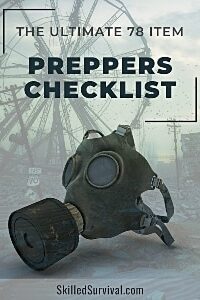
Want a free 78 item prepper checklist?
Click here to instantly download this Complete Checklist PDF. No purchase necessary.Everyone Should Have At Least One
If you are in the military or a police officer, it’s a no-brainer.
You should carry one because you put yourselves in harm’s way daily.
What about everyone else?
You are on this website interested in prepping and survival information.
That’s a good thing.
Anyone interested in outdoor life and wilderness adventures should own an IFAK medical kit.
Accidents can happen, whether camping, fishing, hiking, or hunting.
Being prepared for any situation is crucial.
Among the essential survival items is your first aid supplies.
Included on that list is a tourniquet.
They will help you with puncture wounds, gunshots, and fall injuries.
It’s an essential medical device you hope never to use.
7 Types Of Tourniquets (Pros & Cons Of Each)
There are several types.
And they are all designed to do the same thing.
Stop a massive hemorrhage by creating circumferential pressure and cutting off blood flow.
It’s best to practice with various ones to see what you are most comfortable using.
Here’s a good overview video showing the differences (or read our breakdown below):
↓ The 5 Different Types (Pros | Cons)
1. MET – Military Emergency Tourniquet
A MET is a lightweight option with a strong strap and a windlass made of aluminum.
The MET comes apart entirely as it is an open-loop system allowing you to put it around a limb quickly.
You apply it loosely, letting the windlass take up all the slack until it’s tight.
Next, you can secure it at two points for a complete lockdown.
The MET comes in 3 generations. Gen 1&2 has a narrow band, while Gen 3 is wider.
Note: You may require training for their model if you’ve never used one.
PROS
- Easy to wrap around limbs
- Multiple lockdown points
CONS
- Earlier generations were too narrow
2. SOF-T Special Operations Forces Tourniquet
Another truly open-loop option is the SOF-T.
It has several versions, with the earlier ones having a narrow strap with an alligator clip and locking screw.
When applied, two D-rings (made out of plastic) secure the metal windlass.
You must secure the locking screw before using the windlass.
Otherwise, it will loosen.
The strap is wider with a break-apart buckle replacing the screw and clip-on newer generations of the SOF-T.
This change was made possible by going down to one D-ring for locking down the windlass.
PROS
- Ease of use
- Windlass is made with a more robust aluminum
CONS
- The narrower SOF-T can cause nerve damage if it’s left on too long
3. CAT – Combat Application Tourniquet
The military partially uses a CAT design because it was the first manufactured one.
The CAT has gone through many versions over the years.
Fortunately, the latest ones have corrected older performance issues.
When used, the strap is completely independent of wrapping around a limb.
So you must secure the strap before using the windlass.
A CAT is a closed-loop system with just a three-inch uptake.
Velcro helps secure the strap.
But depending on a lower or upper limb, it feeds through the buckle differently.
There is only one locking point for the windlass on the CAT.
PROS
- Less pressure is required for total occlusion of the artery
- Less potential for lasting nerve damage
CONS
- Can slip in wet weather
- The windlass can more easily break due to its plastic makeup.
4. RMT – Ratchet Medical Tourniquet
The RMT is another closed-loop option.
It comes with a broad strap that can be fully opened for getting around trapped limbs.
There is a ratcheting, self-locking buckle for tightening with a simple release mechanism.
These are designed for easy single-handed application and are compact and lightweight.
It works great but uses this more as a backup for one of the models above.
PROS
- It can easily fit into your IFAK
- Single-handed use
CONS
- Best used as a secondary option
5. EMT – Emergency Medical Tourniquet
Here we have the emergency medical design.
The EMT looks similar to a blood pressure cuff at the doctor’s office.
It has an aluminum clamp to secure it instead of velcro.
It’s an open-loop system, so it’s pretty easy to use and lightweight.
Pressure is applied through a pneumatic bladder that you hand pump up.
Its easy use can be applied one-handed if necessary.
The EMT is less compact than other options, so you should consider that when building a trauma kit.
PROS
- Less chance of tissue damage with its wide band
- More comfortable than a band type
CONS
- More expertise and bulkier than windlass types
6. MAT – Mechanical Advantage Tourniquet
The MAT is another design you can apply with one hand.
It comes in two sizes; one for an arm and one for a leg.
An internal mechanism tightens using a plastic dial that draws up the cord to restrict your artery.
It also has a quick-release button.
You do have to get the strap tight around the limb before turning the dial, as it has limited uptake.
As a closed-loop system, you can easily remove the strap to get around the limbs and hook it back in.
PROS
- Great one-handed use
CONS
- Plastic parts that may not last
- Limited strap uptake with the dial
7. Band Tourniquets – TK4, SWAT-T, NATO
These are simple elastic rubber bands you wrap around a limb.
Pressure is applied by repeatedly wrapping tighter, creating compressive force.
You must apply a band style properly to be effective and restrict blood flow.
It is better suited to smaller limbs to ensure full restriction. Checking tightness is a must.
PROS
- Simple, lightweight design
- It easily fits small and large limbs
CONS
- It can take longer to apply
- Just a giant rubber band
- Elastics can break, causing limb damage
All these tourniquets will give you blood flow restriction to a significant injury.
They all have pros and cons, so take the time to see what works best for you.
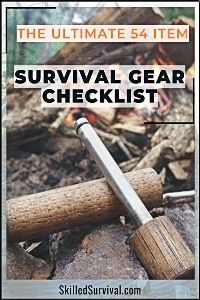
Want a free 54 item survival gear checklist?
Click here to instantly download this Complete Checklist PDF. No purchase necessary.W7 hat To Look For In A Tourniquet
You would think that choosing one would be easy, but that isn’t the case.
Buying the least expensive may not get you what you need in a think-fast-or-die situation.
That’s why you should have several different options for different situations.
Remember, the best tourniquet is the one that is right for you.
Durable Parts
You don’t want a device that will break before you can get to a doctor.
It’s hard to avoid plastic parts but look for metal parts depending on the style.
The windlass should be aluminum so that it will stand up to pressure.
Also, the straps, bands, clamps, and locking mechanisms must be tough.
Ease of Use
You must react quickly to save a life when a major accident happens.
Having one you can put on quickly makes all the difference.
It’s in life-or-death situations where research is important.
Understand how different designs work and choose the ones you can confidently use.
One-handed ones are great if you hike or camp alone.
Wide Band
Having a wider band makes reaching occlusion easier.
It restricts blood over a larger surface area and lessens the chance of nerve damage.
Both strap and band options have their advantages.
So to fully prepare, pack both styles.
Ultimately you want to save a life and not cause any other damage.
Having a wide band plays a significant role in its effectiveness.
Final Thoughts
Ultimately, a tourniquet is the most crucial life-saving device you can carry.
Get a few different ones and add them to all your survival bags.
Having one on hand and knowing how to use it will save your life or the lives of those you love.
Now get geared up!
Why Trust Skilled Survival...
Go here now to review a full breakdown of:
- Who We Are
- Our Credentials
- Our Mission
- & Product Recommendations...
Here are a few highlights of our teams credentials & certifications:
- Certified Member of a Mountain Search & Rescue Organization
- Plant Emergency & Safety Leader for a Major Food Manufacturer
- Member of the 10TH Mountain Division Hut Association
- Certifications: Avalanche 1, WFR, CPR
- Official Gear Tester for Numerous Outdoor Gear Companies
- Countless Multiday Backpacking trips into Remote Wilderness
- Bachelor's Degree In Mechanical Engineering
- Bachelor's Degree In Civil Engineering
- Bachelor's Degree In Biomedical Engineering
"It takes 20 years to build a reputation and five minutes to ruin it." - Warren Buffett
We're fully aware that TRUST is NOT something you GET but is EARNED.
And we'll continue to earn YOUR trust through our forthright and honest approach with each new Blog Post, Guide & Product we create...
Jason K.
P.s. Do You Live In A 'Danger Zone' County?
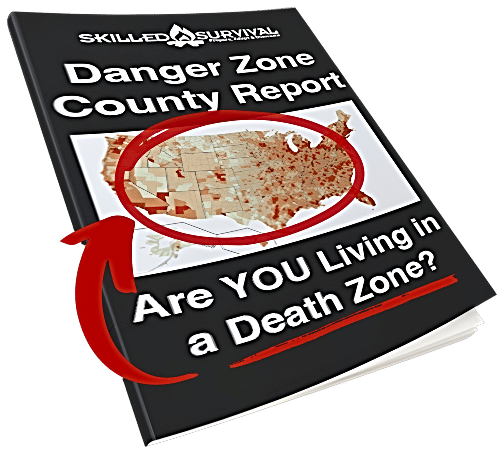
Find out now using my Danger Zone County List & Special Report it’s absolutely FREE.
In minutes you’ll know EXACTLY where you stand and if you should be worried or not..
So click here to get my FREE Danger Zone County List & Report…

Recommended Reading
10 Best Trauma Kits Even The Most Qualified EMTs Will Love
Not all medical kits are created equal, some are excellent, but many are not. We show you the difference and best trauma kit builds.
Best IFAK Kits For Serious Everyday Medical Emergencies
The best ifak kits are innovative, compact, lightweight and 100% worth carrying daily! In this guide, we review the best ones to make your search easy.
Home Doctor Book Review: The Truth Behind This New Release
The Home Doctor is a comprehensive medical handbook book written for those willing to attend to medical issues in times of societal breakdown.
